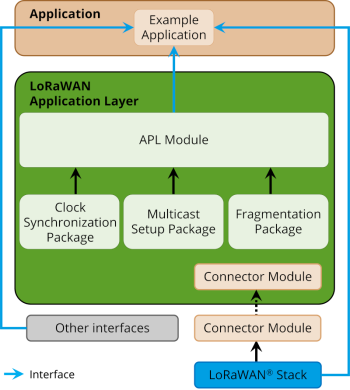In the world of the Internet of Things (IoT), regularly updating firmware is crucial for device security, functionality, and longevity. LoRaWAN® provides an efficient method for distributing firmware updates wirelessly and simultaneously to multiple devices via Firmware Update Over-The-Air (FUOTA).
With the LoRaWAN® Application Protocols Module from STACKFORCE, implementing FUOTA becomes even easier and more flexible. This module is stack-independent and is easy to integrate, making it ideal for a wide range of IoT applications.
What is FUOTA?
FUOTA enables firmware updates to be distributed over the LoRaWAN® network without physical access to the devices. This is especially beneficial for devices deployed in remote or hard-to-reach locations, or in large numbers.
Benefits of FUOTA:
- Scalability: Simultaneous updates to many devices.
- Efficiency: Reduced energy consumption through multicast transmissions.
- Security: Authentication and integrity checks for firmware files.
- Cost Savings: Less need for on-site maintenance.
6 Steps to Successful FUOTA
- Device Identification: Select the devices to be updated and group them into multicast groups.
- Firmware Generation: Create the new firmware file for the target devices.
- Distribution: Transfer the firmware to the multicast group.
- Authentication: Each device verifies the firmware signature.
- Installation: Devices install the new firmware.
- Status Reporting: Devices report whether the update was successful or not.
Core Components of the FUOTA Process
- Clock Synchronization
Synchronizes the internal clocks of the devices with the network to enable coordinated reception times for multicast messages. - Remote Multicast Setup
Allows the creation and management of multicast groups, including the definition of sessions and assignment of devices. - Fragmented Data Block Transport
Splits the firmware into smaller fragments and implements error correction mechanisms to ensure reliable transmission.
Ready to Implement FUOTA in Your IoT Project?
Simplify your over-the-air firmware updates with the LoRaWAN® Application Protocols Module from STACKFORCE.
This modular, stack-independent solution supports essential FUOTA components like Clock Synchronization, Remote Multicast Setup, and Fragmented Data Block Transport — all designed for seamless integration across a wide range of IoT devices.
The LoRaWAN® Application Protocols Module by STACKFORCE
The LoRaWAN® Application Protocols Module is an advanced collection of modules that enhance the functionality of the LoRaWAN® protocol, with a special focus on simplifying FUOTA implementation.
Key Features:
- Stack Independence: Compatible with different LoRaWAN® stacks.
- Modular Architecture: Consists of the three core FUOTA modules, plus additional components for simplified integration.
- Unified Interface: The APL module allows FUOTA execution via a single interface.
- Portability: The connector module bridges application logic and stack-specific parameters.
- Extensive Documentation: Eases integration and usage of the module.
Supported Specifications:
- TS003-1.0.0: Clock Synchronization
- TS004-1.0.0: Fragmented Data Block Transport
- TS005-1.0.0: Remote Multicast Setup
Request an Evaluation License
FUOTA offers a powerful method for efficient and secure firmware updates in IoT environments using LoRaWAN®. The LoRaWAN® Application Protocols Module by STACKFORCE significantly simplifies the implementation of this process, providing a flexible and stack-independent solution for a wide range of use cases.
Interested in testing the module? Request a free evaluation license for the LoRaWAN® Application Protocols Module now and experience the benefits firsthand.


